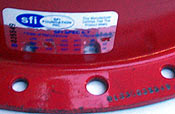|

 |
 |
| Lakewood's
steel bellhousings are designed to contain a severe clutch
explosion. In fact the SFI 6.1 (Sema
Foundation, inc.) test to ensure containment is to
cut apart a flywheel spinning at high rpm until it shatters.
If the bellhousing can contain the pieces, it achieves
the SFI certification sticker (below.) Currently only
Lakewood bellhousings are SFI certified. |

The
SFI certification is only good for two years. Technically
this means you need to replace the bellhousing every two
years. This baffles us since this isn't a component that
wears out. Furthermore we've never heard of a tech official
checking the date on the tag. |
Installing a blowproof steel bellhousing is a pain in the
neck, but probably nowhere near as hard as walking without
any feet. A while back we had the pleasure of learning first
hand the dangers of a clutch explosion. FM staffer Jim Langely
and I were out at Sacramento Raceway early last year -Jim
was in his '65 coupe and I was in Project 11.99. We had the
opportunity to race each other, so naturally we decided to
go all out. At the time the project car was running high 12's
and Jim's coupe was in the 13's. I remember getting past the
1/8th mile point when a flicker of light caught my attention.
I looked in the rear view mirror and saw sparks and smoke
under Jim's car. I lifted and coasted off the track and waited
for Jim. As his car made it to the return road I notice smoke
pouring out from under the hood. Jim's first comment as he
got out of the car was "I think I threw a rod."
We popped the hood, and tried to find the engine damage in
the smoke filled darkness. Like staring at one of those 3D
dinosaur posters, it wasn't clear to me at first what had
broke, but then it suddenly came into view...the bellhousing
was gone! I remember saying "dude, look behind the engine,
you can see the input shaft!." It was then that we realized
the clutch pressure plate had failed and exploded.
The next day in the light we were able to see the extent
of the damage (see side bar). Fortunately Jim wasn't physically
injured, but as the pictures show the resulting damage was
enough to put the car out of commission for quite a while.
The NHRA requires a blowproof bellhousing be installed in
all cars running 11.99 or faster. Yet Jim's coupe was only
running in the 13's when the clutch failed, proving that any
car with a clutch is subject to this sort of disaster. He
had launched the car at around 5000 rpm on Mcreary tires.
Like most clutch failures, his pressure plate gave out on
the 2-3 shift, not at the launch like you'd expect. What caused
it? Ultimately the answer is heat. Pressure plates, clutch
disks, and flywheels generate huge amounts of heat, which
overtime fatigues the metal and causes stress cracks. A 5000
rpm launch on a slipping, stock clutch was probably the fuse.
The majority of stock bellhousings are aluminum and offer
absolutely no containment in the event of a clutch failure.
In fact the stock T5 bellhousing fragmented into so many pieces,
we were lucky the transmission didn't drop right out!
Needless to say the experience made it very clear to both
of us that we needed blowproof bellhousings. NHRA rules require
an SFI approved bellhousing. We looked into two brands of
bellhousings (Mcleod and Lakewood) and found that only the
Lakewood is SFI approved -making the choice very easy.
One look at the Lakewood bellhousing and it's clear that
it is built to handle an explosion. Hydro-pressed out of heavy-gauge
steel it weighs 40 lbs. or so, and is significantly larger
than a stock bellhousing. In addition the block plate is also
made from steel, rather than aluminum, and is bolted to the
bellhousing with grade-8 fasteners. Continue
|

